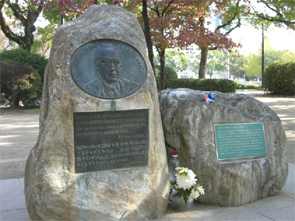
Date of completion
August 2, 2003
Established by
Committee for Monument to Mr. Norman Cousins
Designer
Masanami Yoshida
(then a teacher at Hijiyama Women Junior College)
Shape
The monument consists of two fieldstones — one about 120 centimeters high, the other about 80 centimeters high. Placed on the front side of the larger fieldstone are a portrait in relief of Mr. Norman Cousins and a bronze plate engraved with words in both English and Japanese, quoted from his book Human Option. Embedded in the front of the smaller fieldstone is a green copperplate indicating his contributions to Hiroshima, lettered in gold Japanese characters.
Motive for the erection
To honor Mr. Norman Cousins' great achievements, including promotion of the moral adoption project for A-bomb and war orphans, his efforts in helping female A-bomb survivors receive keloid treatment in the U.S. and his continued appeal to the world for elimination of nuclear weapons treatment in the U.S. and his continued appeal to the world for elimination of nuclear weapons
Epigraph
"World peace will not be achieved by drift or default. The goal must be defined, the approaches must be accepted, the responsibilities must be fixed. (Norman Cousins)"
Noteworthy characteristics
- Mr. Norman Cousins (1915 - 1990)
Mr. Norman Cousins visited Hiroshima in August 1949 as the editor-in-chief of the New York literary journal Saturday Review of Literature, and published a report titled "Hiroshima — Four Years Later." In this report he introduced the idea of "moral adoption," a system that could help nurture A-bomb and war orphans without recourse to legal adoption. Through this "moral adoption" system, Americans of goodwill could contribute to the well-being of overseas children through financial support. Financial support for orphans in Hiroshima through the system amounted to ¥20 million; some 500 children received assistance.
Moreover, in 1955, Cousins took 25 female A-bomb survivors to the U.S. to have their keloids treated at Mount Sinai Hospital in New York by Dr. Arthur Barsky and other world-renowned plastic surgeons.
To honor his achievements, he was awarded the title Honorary Citizen of Hiroshima in 1964.